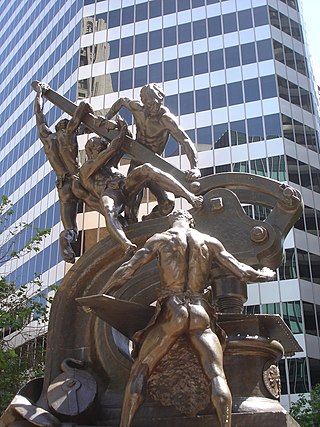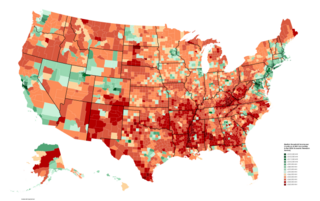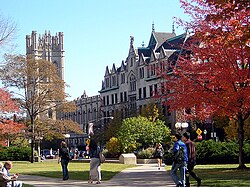
Social class in the United States refers to the idea of grouping Americans by some measure of social status, typically by economic status. However, it could also refer to social status and/or location. The idea that American society can be divided into social classes is disputed, and there are many competing class systems.

Social mobility is the movement of individuals, families, households or other categories of people within or between social strata in a society. It is a change in social status relative to one's current social location within a given society. This movement occurs between layers or tiers in an open system of social stratification. Open stratification systems are those in which at least some value is given to achieved status characteristics in a society. The movement can be in a downward or upward direction. Markers for social mobility such as education and class, are used to predict, discuss and learn more about an individual or a group's mobility in society.

In sociology, the upper middle class is the social group constituted by higher status members of the middle class. This is in contrast to the term lower middle class, which is used for the group at the opposite end of the middle-class stratum, and to the broader term middle class. There is considerable debate as to how the upper middle class might be defined. According to sociologist Max Weber, the upper middle class consists of well-educated professionals with postgraduate degrees and comfortable incomes.
A clerk is a white-collar worker who conducts record keeping as well as general office tasks, or a worker who performs similar sales-related tasks in a retail environment. The responsibilities of clerical workers commonly include record keeping, filing, staffing service counters, screening callers, and other administrative tasks. In City of London livery companies, the clerk is the chief executive officer.
Sociologists use the concept of occupational prestige to measure the relative social-class positions people may achieve by practicing a given occupation. Occupational prestige results from the consensual rating of a job - based on the belief of that job's worthiness. The term prestige itself refers to the admiration and respect that a particular occupation holds in a society. Occupational prestige is prestige independent of particular individuals who occupy a job. Sociologists have identified prestige rankings for more than 700 occupations based on results from a series of national surveys. They have created a scale and then rank given occupations based on survey results.

Household income is an economic standard that can be applied to one household, or aggregated across a large group such as a county, city, or the whole country. It is commonly used by the United States government and private institutions to describe a household's economic status or to track economic trends in the US.
Life chances is a theory in sociology which refers to the opportunities each individual has to improve their quality of life. The concept was introduced by German sociologist Max Weber in the 1920s. It is a probabilistic concept, describing how likely it is, given certain factors, that an individual's life will turn out a certain way. According to this theory, life chances are positively correlated with one's socioeconomic status.
Though the American middle class does not have a definitive definition, contemporary social scientists have put forward several ostensibly congruent theories on it. Depending on the class model used, the middle class constitutes anywhere from 25% to 75% of households.

The educational attainment of the U.S. population refers to the highest level of education completed. The educational attainment of the U.S. population is similar to that of many other industrialized countries with the vast majority of the population having completed secondary education and a rising number of college graduates that outnumber high school dropouts. As a whole, the population of the United States is spending more years in formal educational programs. As with income, levels differ by race, age, household configuration, and geography.
The American upper class is a social group within the United States consisting of people who have the highest social rank, due to economic wealth, lineage, and typically educational attainment. The American upper class is distinguished from the rest of the population due to the fact that its primary source of income consists of assets, investments, and capital gains rather than wages and salaries. The American upper class is estimated to be the top 1% of the population.
The African-American middle class consists of African-Americans who have middle-class status within the American class structure. It is a societal level within the African-American community that primarily began to develop in the early 1960s, when the ongoing Civil Rights Movement led to the outlawing of de jure racial segregation. The African American middle class exists throughout the United States, particularly in the Northeast and in the South, with the largest contiguous majority black middle-class neighborhoods being in the Washington, DC suburbs in Maryland. The African American middle class is also prevalent in the Atlanta, Charlotte, Houston, Dallas, Los Angeles, New Orleans, New York, San Antonio and Chicago areas.
Status attainment is the process of one attaining one's positions in society, or class. Status attainment is affected by both achieved factors, such as educational attainment, and ascribed factors, such as family income. The theory of status attainment states that one can be mobile, either upwardly or downwardly, in the form of a class system.

Affluence refers to an individual's or household's economical and financial advantage in comparison to others. It may be assessed through either income or wealth.
The terms average Joe, ordinary Joe, regular Joe, Joe Sixpack, Joe Lunchbucket, Joe Snuffy, Joe Blow, Joe Schmoe, and ordinary Jane, average Jane, and plain Jane, are used primarily in North America to refer to a completely average person, typically an average American. It can be used both to give the image of a hypothetical "completely average person" or to describe an existing person. Parallel terms in other languages for local equivalents exist worldwide.

In the United States, the lower class are those at or near the lower end of the socioeconomic hierarchy. As with all social classes in the United States, the lower class is loosely defined and its boundaries and definitions subject to debate and ambiguous popular opinions. Sociologists such as W. Lloyd Warner, Dennis Gilbert and James Henslin divide the lower classes into two. The contemporary division used by Gilbert divides the lower class into the working poor and underclass. Service and low-rung manual laborers are commonly identified as being among the working poor. Those who do not participate in the labor force and rely on public assistance as their main source of income are commonly identified as members of the underclass. Overall the term describes those in easily filled employment positions with little prestige or economic compensation who often lack a high school education and are to some extent disenfranchised from mainstream society.

Socioeconomic status (SES) is an economic and sociological combined total measure of a person's work experience and of an individual's or family's access to economic resources and social position in relation to others. When analyzing a family's SES, the household income and the education and occupations of its members are examined, whereas for an individual's SES only their own attributes are assessed. Recently, research has revealed a lesser-recognized attribute of SES as perceived financial stress, as it defines the "balance between income and necessary expenses". Perceived financial stress can be tested by deciphering whether a person at the end of each month has more than enough, just enough, or not enough money or resources. However, SES is more commonly used to depict an economic difference in society as a whole.

The society of the United States is based on Western culture, and has been developing since long before the United States became a country with its own unique social and cultural characteristics such as dialect, music, arts, social habits, cuisine, and folklore. Today, the United States is a racially and ethnically diverse country as a result of large-scale immigration from many countries throughout its history.
In the United States, the concept of a working class remains vaguely defined, and classifying people or jobs into this class can be contentious. Economists and pollsters in the United States generally define "working class" adults as those lacking a college degree, rather than by occupation or income. Many members of the working class, as defined by academic models, are often identified in the vernacular as being middle-class, despite there being considerable ambiguity over the term's meaning. According to Frank Newport, "for some, working class is a more literal label; namely, an indication that one is working."
In the United States, despite the efforts of equality proponents, income inequality persists among races and ethnicities. Asian Americans have the highest median income, followed by White Americans, Hispanic Americans, African Americans, and Native Americans. A variety of explanations for these differences have been proposed—such as differing access to education, two parent home family structure, high school dropout rates and experience of discrimination and deep-seated and systemic anti-Black racism—and the topic is highly controversial.

Socioeconomic mobility in the United States refers to the upward or downward movement of Americans from one social class or economic level to another, through job changes, inheritance, marriage, connections, tax changes, innovation, illegal activities, hard work, lobbying, luck, health changes or other factors.










